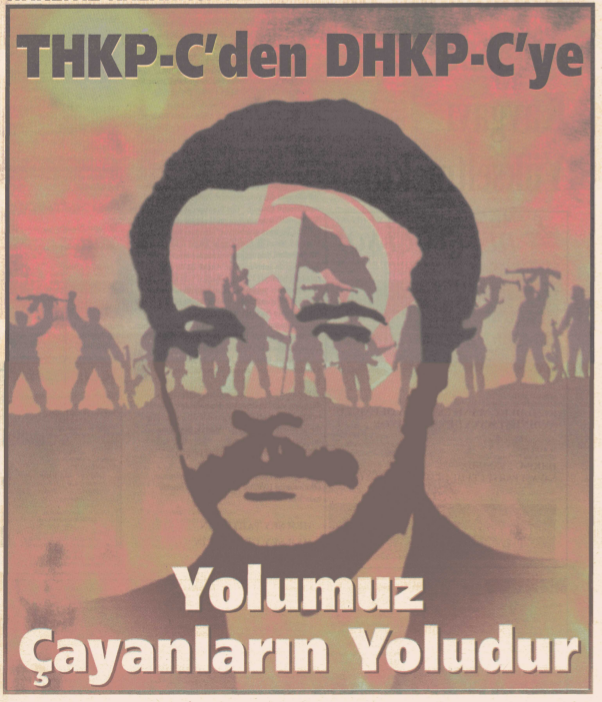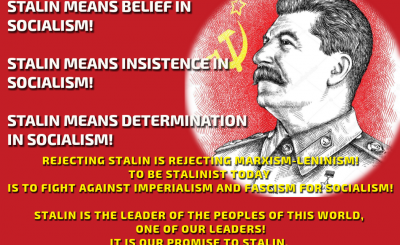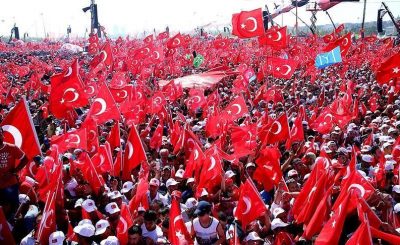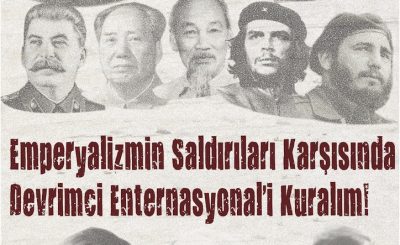Several dates are of great importance in the history of our movement. March 30, 1972 was the day when leading cadres of the THKP-C died fighting at Kizildere, writing the manifesto of Turkey’s road to revolution through their resistance. March 30, 1994 was the date when the DHKP (Revolutionary People’s Liberation Party) was founded. July 12, 1991 and April 17, 1992 were dates when the oligarchy martyred numerous cadres and fighters of our movement. Every year, the period March 30-April 17 is when we commemorate our martyrs.
THE OLIGARCHY’S POLICY OF DESTRUCTION AND OUR UNBEATABLE REVOLUTIONARY WAR
The THKP-C confronted the oligarchy with the danger of a revolution resulting from the armed struggle. In the 1970s the ruling classes of the republic which had existed for 50 years had faced Kurdish rebellions, minor reactionary uprisings, illegal organisations and the struggle of the TKP (Communist Party of Turkey), which called for revolution. However, the rulers never felt their power was threatened by them. This was because these movements did not contain within them the urge to take power. The Kurdish rebellions took place at local level and were nationalistic. The reactionary rebellions were also local and were merely a response to what was happening. And the TKP was far from having a form of struggle which thought in terms of taking power, even though this was in their programme. In the second half of the 1960s, the TIP (Labour or Workers’ Party of Turkey) developed quickly, taking its place in the political arena with a call for “changing the regime”. It managed to gather behind it a section of the masses, and 15 members of the TIP were elected to parliament. Despite its parliamentary and reformist character, this was a result of the development of socialism and it was this that disturbed the oligarchy. However, the oligarchy saw no threat to the system from the TIP and its struggle, for the TIP was socialist in words but its struggle was confined within the limits placed by the system and took the current parliamentary system as the basis. It was far from being able to overthrow the power of the oligarchy or even create the conditions for it.
The struggle which was directly aimed against the oligarchy’s power took shape at the start of the 1970s in the form of armed struggle, especially on the part of the THKP-C. This was because the THKP-C was a party which aimed to achieve people’s power. Of course that is not enough of itself for a political movement to be viewed as a threat by the rulers. As mentioned earlier, the TIP and other political movements claimed to be aiming for people’s power and socialism. What distinguishes the THKP-C from everyone else is the road it took towards achieving people’s power and socialism. The strategic line of the THKP-C is a line which can achieve this. This road is not simply restricted to theories of people’s power and socialism but is directed towards achieving them in practice. This road means achieving socialism through waging open warfare. It is the road of the Anatolian uprising. Whether to take the armed struggle as a basis or not was the decisive question among the left at that point. Decisive, because the only revolutionary line which could make possible the achieving of power was the line which took armed struggle as its basis. Those who do not follow this line are not part of the struggle for power or are at least far removed from it, no matter what they say. In this sense it can be said that the beginning of a struggle which had power as its aim dates back to the start of the 1970s.
When the oligarchy was confronted with this danger, it carried out a policy aimed at annihilating the revolutionary left. The oligarchy already had official and civil organisations which came about through the domination of imperialism and which were organised to fight the people and wage civil war. However, until the second half of the 1960s these organisations were not often used. Only when the struggle of the revolutionary youth movement under the leadership of those who later founded the THKP-C and the THKO gained ground in the struggle against the regime and established an openly anti-imperialist line did the oligarchy set in motion a counterrevolutionary policy, and the organisations to go with it. These included civil fascists (the Grey Wolves) and official organisations which began to use terror against the revolutionaries and the people. In this period, the murder of revolutionaries started. Attacks by civil fascists and the police against actions by students and workers resulted in the first deaths. On the other hand, peaceful demonstrations turned into occupations, and attacks met with a swift response. Youths learned to make and use Molotov cocktails and eventually came to the understanding that they must acquire firearms. Militant groups began to be formed which could intervene if there were spontaneous clashes. Now a period of radical struggle began in which people fell, and they will continue to fall: in contrast with the revisionist left which for 50 years has been far removed from waging an open struggle with the regime and which fears paying a price and making others pay a price, and is ready neither to die nor to kill. Against the armed struggle of the THKP-C the oligarchy set all its counterrevolutionary organisations in motion. March 12, 1971 was a turning point for the oligarchy. The policy of massacres and annihilation was used completely openly. While those who might cause problems for this policy were liquidated, fascism was institutionalised. The only aim of the March 12 coup was to physically destroy the revolutionary movement. As a consequence of this policy of annihilation and massacre, the leading and fighting cadres of the THKP-C and THKO were brutally murdered and the prisons held more revolutionaries and progressives than had ever been the case previously. The March 12 period ended in physical defeat for the revolutionary movement.
However there was also something the oligarchy did not reckon with: the physical defeat of the THKP-C was also a political victory. It made possible the revolutionary line of the Party-Front’s supporters who never bow down and continue the struggle whatever the conditions. By accepting their physical destruction, they actually ensured the future of the revolutionary movement. They had written down the manifesto which showed the way to the future. The oligarchy destroyed the THKP-C physically at Kizildere but it was able neither to defeat nor destroy the class struggle.
The supporters of the Front after 1974 reorganised themselves, even if not in the form of a party, and developed a line of struggle which delivered even greater blows to the state. In this period too the oligarchy used massacres against the revolutionary leadership. Revolutionary cadres and militants were murdered in particular. Wih the coup of September 12, 1980 the massacres continued and executions were added to the massacres. But the putsch was unable to make physical destruction of the revolutionary movement on a broad scale into an open policy in this period. Only in the 1990s did the oligarchy carry out this policy openly.
More than twenty years have gone by since Kizildere.
For years, the oligarchy could prevent the THKP-C from organising after the annihilation at Kizildere. However, at the beginning of the 1990s, the full force of the armed struggle confronted the oligarchy. The war which developed with the line of the Party-Front, punished the people’s enemies, spread throughout Anatolia and strengthened the hope that the oligarchy sought to destroy at Kizildere. On July 12, 1991 the same type of policy of destruction was used, this time against Devrimci Sol. But they could not achieve the same result. Apart from the fact that they could not deal it a political blow, they did not manage to disorganise the line of the Party-Front. The revolutionary movement could continue its struggle and efforts to organise unhindered.
July 12 is not a one-off attack but simply the result of a particular policy and a crystallisation of the reality of warfare in all its openness. The actual practice of the “Susurluk State” which was exposed recently is directed against our movement but it began on July 12. It is one of the turning points in the open warfare of the Susurluk State against the people and the revolutionaries. This date in the history of the revolution in Turkey is the oligarchy’s attempt to destroy the revolution in Turkey with an all-out attack, to prevent it being revived again. July 12 was a destructive blow aimed at laming the organisation’s existence and preventing it from functioning, just like at Kizildere. In this sense it had no success. But the policy of destruction did not end on July 12, this was only the beginning. After this date a policy was developed in which the murder and execution of Party-Front supporters was completely “legitimised”. Hundreds of Devrimci Sol and DHKP-C fighters were murdered as a result of this policy. The final aim was to annihilate them completely. On April 17, 1992 they tried again. They received an answer they did not expect. While the public were told that “We have crushed their brains”, the Devrimci Sol fighters were able to prevent the police from going out on the street. Afterwards it was clear that the war continued, and after the police chiefs had said “We have dealt with them, destroyed them,” they had to admit with regard to the revolutionary movement that “t is an organisation that quickly repairs the damage it suffers.” But that did not mean the oligarchy was ending its policy of annihilation.
In the following periods its policy developed on this basis. They wanted to use annihilation and betrayal, external and internal blows to achieve a final result.
In the period of treason by the putschists on September 13, 1992, the oligarchy was full of hope that it would achieve a result with its policy of annihilation. The revolutionary movement found itself besieged. While on the one hand the oligarchy used all its contra-guerrilla methods in psychological warfare, on the other it carried on the continual annihilation of Devrimci Sol fighters. This was a period in which from right to left, all forces united to annihilate us. But they were disappointed. While the contra-forces were rendered harmless and the plans of the contra-guerrillas were frustrated, those on the left who with their lies, intrigues and attacks took part in the attempts to encircle us became black spots in the history of the revolution.
Did we use good military equipment and perfect organisation to resist these attacks? Did we use military actions to break the encirclement? No! Neither of these methods were used to break the encirclement. With regard to military strength and organisational structures, this was a period when we were weaker than before. However there were other things that made us strong against the attacks. Devrimci Sol cadres and fighters kept their trust in the organisation and leadership. The resoluteness to fight on held sway, so those who fell were quickly followed by new martyrs. Despite everything we broke through the encirclement and continued our march towards revolution.
We removed the putschists, broke through encirclement and realised our first step of becoming a party.
The policy of annihilation remained on the agenda. But the oligarchy could not prevent the continuity of our struggle. What was decisive here was the resistance of the fighters of Devrimci Sol and the DHKP-C. The ones who were the direct targets of the policy of destruction.
The oligarchy’s attacks aimed at annihilating the revolutionaries were resisted on April 17, in Ankara, Adana and Bagcilar, where a heroic epic was written down. Every one of the oligarchy’s attacks were met with the resistance of our fighters who carried out a line, a tradition, turned it into a warcry with the hoisting of our Party-Front’s flag.
These attacks strengthen no political organisations and can mean the destruction of many. Overcoming them and continuing development was made possible by assimilating the characteristics of the Party-Front.
This period is a history in which we can die but not surrender or deviate from our path, in which we will shout our slogans more loudly, put this into practice and write legends in our own blood. Our people and our party are indebted to our comrades who are the creators of this history and these dignified legends.
This legend and history was an open warning to those who are ready for any kind of deviation and conciliation and quite openly replace revolutionary behaviour with bourgeois politics. This legend and history prevented many from deteriorating even further. This resistance does not consist simply of “heroic deeds”, and not just in our country, but they are political actions with which we have transmitted internationalist and socialist consciousness to the whole world. We have shown in times when counterrevolutions have been at their highest point that we had the resolve to defend socialism. Armed resistance during encirclement showed that the counterrevolutionary wind could not prevent the banner of socialism with the hammer and sickle from waving. In this respect it is setting an example for all political movements as well as forming a barricade against rightist deviations. And those who do not see that, who still utter cheap and empty words about the Party-Front and curse, they feel contempt and dream about our annihilation. After these developments, did they abandon their dream? No. For them, such dreams are the only reason they have left to exist. This dream has become the basis of their time-serving. And because of this time-serving, they feel secret joy when the DHKP-C receives blows or when they think it is going over to “reformism”. When for one reason or other they are not able to hear the weapons of the Party-Front for three and a half months or so, they speculate that it no longer has any strength left. Of course, if the Party-Front no longer has any strength or is becoming reformist, then these time-servers could announce their own “vanguardism”. However, these remarks and analyses on the basis of these speculations are quickly disproved in practice. These things they talk of have not occurred, and neither will they occur. As long as the Party-Front line continues to carry on the class struggle in practice, they will carry on with the “literature” of “vanguardism” and “leadership” and merely conduct a struggle to maintain their own existence. This is how the situation of the left can be described.
And those who have uncovered our reformism! While you utter these cheap words you do not see the history we have experienced, nor what will happen. Have you forgotten what you have seen? What history, resistance and victory do you base yourselves on? There are things such as responsibility, morality and consciousness of history. Speak but don’t act – you can add nothing new to what has been said for 30 years. While you talk so cheaply, history is being written over and over again.
History is not written with cheap words at a table, but written within life itself.
Do you think we are betraying our martyrs and our history. Those who think so have not understood the THKP-C and DHKP-C, nor have they understood our morality, revolution and our understanding of revolutionary behaviour. Those who think that way are mistaken. They show their own weaknesses and how they can deviate at any moment in any direction. We are the “most stubborn people” in the world, the whole world can deviate as was the case during the Gorbachev period, stray from the path, commit betrayal. We will continue marching along our path, remain seated in our Marxist chair and keep our heads. Dozens, hundreds of us are murdered, our units are wiped out but we do not give up and we continue the war. Wait and you will see. But you will not even be ashamed of the words you uttered and one day you will even lose respect for yourselves because of your inability to look ahead, your ignorance of life and the war and your lies. The invincibility and resolve of a movement to continue and develop the war despite the terror which the entire oligarchy uses is something which, with regard to the left in our country, ought to be looked into. Everyone can learn from it.
What was done during the March 12 and September 12 juntas? What happened at Kizildere, on July 12 and September 12, and how did people behave afterwards? In answering all these questions the tradition of the Party-Front has to be taken into account. Our party’s connection to the people and the revolution and its willingness to strive for and take power. History has condemned those who called Kizildere “suicide”. It is easy to criticise and come up with theories, even after 25 to 30 years, that the Mahirs ought to have gone abroad. This means that these people understood nothing of the revolutionary upheaval in the 1970s and the THKP-C movement. There are those who do not criticise because they know that history was written at the time by the Mahirs and not by the people who chose to emigrate. Nobody remembers the names of those who did not fight because they separated themselves from the class struggle. In the end this is all to be expected from those who do not fight. The THKP-C overcame all the usual criteria in existence up until its time, all the revisionist and opportunist words, it destroyed the status quo. Admittedly, the blows dealt out on March 12 and after meant that the organisational continuity of the movement could not be maintained, there was an interruption, even if it did not last long. But this was normal in terms of the experience of the movement at the time. The future was built during this time of sacrifices. The Party-Front took on this inheritance and developed it. In this way it was possible to overcome July 12 and April 17.
It has reached a point where it can carry on the struggle even if not just dozens but hundreds of its leading cadres have been lost. This was made possible by Kizildere.
Those who try to “condemn” the Mahirs and the THKP-C under these conditions are also unable today to understand the struggle of Devrimci Sol and the DHKP-C. They think of this war as a “duel” and think that the oligarchy will emerge victorious from this war. Those who think this way do not believe in the revolutionary war or in the people and are outside the people’s reality.
The essence of a war is that no victory can be achieved against the oligarchy without paying a price. Whoever wants to win a war and sincerely and decisive aspire to power must also be prepared to pay such a price. War only gives a chance to those who recognise its rules and its laws.
For those who are outside the war and people’s reality and who are afraid of the price it will demand, the end will come in the form of political reformism, betrayal and fleeing from the war. This is the reason and there is no other why people like Münir Aktolga and Yusuf Küpeli who occupied the highest positions inside the THKP-C, turned into worms who gnawed at the party from within. This is the reason why a movement like Devrimci Yol (Revolutionary Path) which conducted an armed struggle of its own and had hundreds of martyrs, turned into the ÖDP (Freedom and Solidarity Party, an organisation hostile to the armed struggle), or why those who had various tasks in the movement carried out the putsch of September 13 and all the treason that went with it. When did the Münirs carry out the rightist deviation and commit treason? When Cevahir had been shot dead, Mahir and dozens of other cadres and fighters of the Party-Front had been arrested and the oligarchy’s encirclement was tightening. To justify their liquidationist and treacherous position, they declared that “at that time we did not understand Marxism-Leninism but now we do.” No, that has nothing to do with reality. What actually happened was that they were confronted with the reality of warfare and feared what this reality meant. Devrimci Yol’s discovery of the road to creating a legal party, the TDKP (Revolutionary Communist Party of Turkey) discovery of the need for an open party for the working class – these discoveries were not arrived at following a period of discussion, they were arrived at in Mamak (a prison run by the army following the 1980 coup). The cadres who in Mamak were directly confronted with the price of the war and who always had in the back of their minds their own political denial, also let down their own cause in the same concealed manner. That is what happened. Those who made the putsch of September 13 were those who could not give up the petit bourgeois dream that revolution was near. The process of the upswing did not proceed without losses as in the beginning, but rather there was a battle with the oligarchy and July 12 happened. When the reality of war was shown on July 12, and the dimension of the price to be paid was obvious, the petite bourgeoisie made its last effort to conquer the organisation to save itself from paying a price and so it went over to treason. The common factor in all these deviations and betrayals which arose at different times and under different conditions was that they capitulated before the reality of war. It does not matter that all their theories differ from one another because they cover up the same surrender. As our people would say, everything happened when they “looked violence in the face”. The greatness of the Party-Front could also be found here. It is a party which goes along the path of struggle. With the conviction that the peoples of Turkey have no other path than the struggle, and with the resolve to be in the first rank of this struggle, it entered the arena of the class struggle. The supporters of the Party-Front have been fighting for exactly 28 years with this same resolve and conviction. The meaning of the words Mahir used in Kizildere, “We have not come here to turn back, we came here to die,” and the manifesto of this war is that all the fighters in the war, individually and as the Party-Front should be prepared to fight until the last drop of blood. For this reason the slogan “War until liberation” is one of the basic slogans of the Party-Front.
The DHKP-C is convinced that from Mahir to the present no price is in vain. The proof of this is that the name of our hope is “DHKP-C” and tens of thousands are assembled under the banner of the Front. This is also eidence of the invincibility of the Party-Front.
The DHKP-C is an organisation for waging war. As long as such an organisation does not surrender, no defeat or blow can succeed in annihilating it.
Defeat is final when one surrenders. Those who do not surrender turn their defeats into victories. The history written in Kizildere and on July 12 is just such a history.
The DHKP-C is a people’s movement. Nowhere have the ruling classes ever succeeded in completely annihilating a people though massacres.
The DHKP-C in invincible for these reasons. The oligarchy’s policy of annihilation has failed over the past 28 years, and it is doomed to failure.
Victory will be ours.
Source: Devrimci Sol(Revolutionary Left) magazine May 1998




